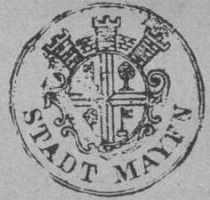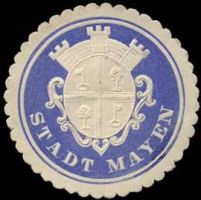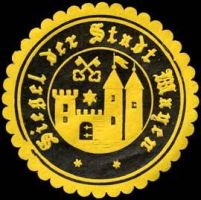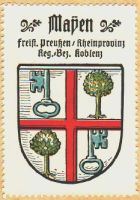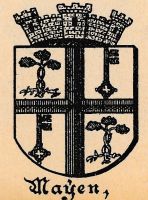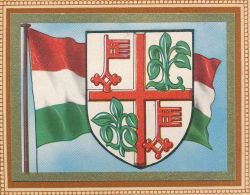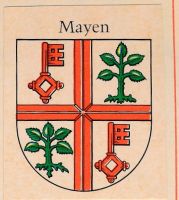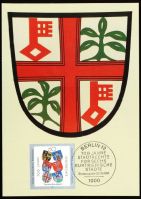Mayen: Difference between revisions
Knorrepoes (talk | contribs) No edit summary |
Knorrepoes (talk | contribs) No edit summary |
||
| Line 14: | Line 14: | ||
* 1970 Nitztal | * 1970 Nitztal | ||
** 1967 Kürrenberg | ** 1967 Kürrenberg | ||
** 1967 Sankt Johann-Nitz | ** 1967 Sankt Johann-Nitz | ||
{{#display_map:50.3280,7.2212|width=250|height=250|zoom=7}} | {{#display_map:50.3280,7.2212|width=250|height=250|zoom=7}} | ||
Revision as of 10:05, 21 May 2023
|
Country : Germany State : Rheinland-Pfalz District (Kreis) : Mayen-Koblenz (until 1970 Mayen) Additions:
|
| German | In Silber ein durchgehendes, facettiertes, rotes Balkenkreuz, oben rechts und unten links begleitet mit einem linksgewendeten roten Schlüssel, oben links und unten rechts mit einem fünfblättrigen grünen Baum (Maibaum-Buche), jeweils den Querbalken teilweise belegend. |
| English | blazon wanted |
Origin/meaning
Mayen got city rights in 1291, and the oldest seal of the city dates from the same year. It shows a castle below two crossed keys. The keys symbolise the fact that the city belonged to the State of Trier. The patron saint of Trier is St. Peter, whose symbol is a key or, as it is often displayed, two crossed keys. Later seals show the same composition.
The first seal showing a different composition dates from 1429, and shows a cross, with in each corner a key. The present arms are based on this seal. The trees are so-called May-trees (or freedom-trees), which are a canting symbol (Mai-baum, or Maie).
Hupp showed the arms in the 1920s in a different composition, see below.
The arms in the Abadie albums
The arms by Hupp in the Kaffee Hag albums +/- 1925
The arms in an album from around 1910
The arms in an album from around 1950
The arms in an album from 1968
Literature: Stadler, 1964-1971, 8 volumes




